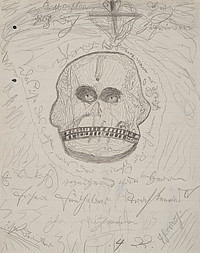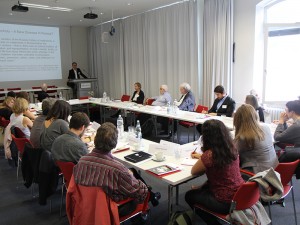 Dr Åsa Jansson recently completed her PhD at the Centre for the History of the Emotions at Queen Mary University of London. Her thesis mapped the re-conceptualisation of melancholia as a modern biomedical mental disease in Victorian medicine.
Dr Åsa Jansson recently completed her PhD at the Centre for the History of the Emotions at Queen Mary University of London. Her thesis mapped the re-conceptualisation of melancholia as a modern biomedical mental disease in Victorian medicine.
In this blog post Åsa offers her reflections on the conference ‘Gloom Goes Global: Towards a Transcultural History of Melancholy since 1850’, held at the Cluster of Excellence: Asia and Europe in a Global Context, Karl Jaspers Centre for Advanced Transcultural Studies, Univeristät Heidelberg, October 2-4, 2014.
Some topics never seems to go out of fashion. At least since antiquity, philosophers, writers, artists, and doctors have been preoccupied with melancholy, or melancholia. The words derive from the Greek μέλας (melas) χολή (kholé), meaning ‘black bile’. For centuries it was believed that black bile (one of the four bodily humours) originating in the gastric region would overflow and rise to the head, cloud the soul and cause sadness and dejection. Humoural theories have long fallen out of use, but melancholy continues to evoke questions to which no definitive answers exist. What is melancholy? Is it an emotion? An illness? A literary trope? What does it mean to be melancholic? Have people everywhere, in all times, experienced melancholy? And what – if any – is the difference between melancholy and melancholia? These questions (and many others) were addressed last week at the conference ‘Gloom Goes Global: Towards a Transcultural History of Melancholy since 1850’, hosted by the Asia-Europe Cluster of Excellence at Heidelberg University.

Is this what melancholy looks like? Image from the conference poster. «Dies ist das letzte, was der Mensch noch nach seinem Tode zu erwarten hat» Pencil drawing from an exercise book by Johann Faulhaber, ca. 1908 ©Sammlung Prinzhorn Heidelberg, Inv.Nr. 1511
The conference lived up to its name. The meeting in Heidelberg was both genuinely transcultural and interdisciplinary, reflecting the ambivalent – or rather multivalent – nature of the topic at hand. As anyone familiar with the history of melancholy will know, this word has never referred to one, easily identifiable thing. Moreover, discussions of melancholy tend to draw in a number of other words and concepts that have at various times been perceived as closely related to melancholy and melancholia. Thus, the conference also generated discussions about sadness, grief, neurasthenia (or nervous exhaustion), suicidality, vishaad (dejection), depression, trauma, and nihilism in contemporary art, to name a few.
Over three days of lively discussions, a number of questions emerged that have particular bearing upon the history – and historicity – of the emotions. These were questions of the universality of emotions (do global emotions exist?), of experience versus expression of emotions (are both culturally produced?), and of the ever-shifting and difficult to define border between normal and pathological emotions. Finally, the tendency to relate, or even equate, melancholy with a number of other emotional terms or phenomena brought into focus the question of whether the history of melancholy is best understood as the history of a word or the history of a concept – or both.
But the most heated debates concerned the question of what historians of medicine like to refer to as ‘retrospective diagnosis’ – that is, the act of projecting current medical knowledge onto the past, and diagnosing historical subjects with today’s diseases. In this way, Victorian physicians diagnosed Shakespeare’s Hamlet with melancholia1, late-twentieth-century psychiatrists have given World War I soldiers PTSD2, and medieval saints have been described as schizophrenic.3
It is difficult to spend any considerable time researching the history of melancholy without coming up against the question of retrospective diagnosis. Not least because, in the twenty-first century, when we speak or write about melancholy we tend to do so with another ubiquitous phenomenon in mind – depression. While few would perhaps argue that the two words are synonymous, there is nevertheless a sense that they are closely related. Both denote low mood, dejection, sadness, and both can be used as a an adjective for any kind of sad event or experience – a depressing film, for example – while both can also be used to speak about a medical condition. However, unlike in centuries past, melancholy is no longer a term favoured by the medical community itself, at least not in the English language, which distinguishes between (non-pathological) melancholy and (pathological) melancholia. It is the latter of these – melancholia as a medical condition – that has featured most prominently in late-modern discussions of retrospective diagnosis.

Renaissance artist Albrecht Dürer’s famous depiction of melancholia, 1514. Image credit: Wellcome Library, London.
The three terms melancholy, melancholia, and depression have overlapped throughout history, and in a broad, general sense the use of the latter has grown increasingly popular as the former two have declined. This does not mean, however, that ‘depression’ has simply replaced melancholy and/or melancholia. That there exist such a vast number of different historical narratives about melancholia, melancholy, and depression is not simply a result of different perspectives among today’s historians. Rather, it is a testament to the vast and shifting meanings that these terms have possessed over time. When it comes to melancholia in particular, the word has been used at least since antiquity to describe illness, but not one uniform disease. Thus, rather than speaking about melancholia as a single concept, the word is best understood as corresponding to a number of different – though often overlapping – disease concepts over the last two millennia.
Nevertheless, scholars writing about any of the various historical melancholias have often done so under the assumption that underlying cultural and temporal differences in language and understanding is a more or less timeless condition. In particular, critics of the current model of ‘clinical depression’ that appears to grow increasingly inclusive and opaque, have turned to past descriptions of melancholia in an attempt to show that there exists a core condition – a severe form of depressive state accompanied by psychosis – that has remained relatively stable across time, but which has been eclipsed by the current fashion of extending the term ‘depression’ to an increasingly wide range of emotional states. At the opposite end of the spectrum, historians critical of a positivist and presentist approach reject any notion of a timeless biological model, arguing that emotions are culturally produced and cannot be easily transposed across time based upon present knowledge.
But perhaps the more pertinent question we should ask is not whether we can plausibly diagnose people of the past with today’s illness categories, but rather, should we? What value does this act have? What purpose does it serve? The motivation appears in the first instance to be a legitimisation of present medical knowledge. In other words, if we can show that people have suffered from the same illness throughout history, this knowledge affirms that the illness is, in fact, real. But does it? As one of the conference participants demonstrated, there exists, in the present, sound and verifiable empirical data that supports the existence of a relatively uniform, delineated medical condition that is referred to in current psychiatric literature as ‘psychotic’ or ‘melancholic’ depression, or simply as melancholia. The crux is that the ‘Bible’ of Western psychiatry, the notoriously politicised Diagnostic and Statistical Manual published by the American Psychiatric Association, does not recognise this condition, meaning that people suffering from it risk getting misdiagnosed and consequently excluded from receiving treatment that has been demonstrated to be the most effective in alleviating the symptoms of this debilitating illness. There is, then, undoubtedly an urgent need to demonstrate the validity of this diagnosis.

A woman diagnosed as suffering from melancholia. Lithograph, 1892, after a drawing made for Sir Alexander Morison. Image credit: Wellcome Library, London.
But why do we presume that today’s scientific knowledge is legitimised through a perceived universality across time? This view arguably derives from a Baconian perception of ‘nature’ as something that human beings can observe, intervene with, and learn from, and about which universal truths can be demonstrated through an inductive approach to knowledge. But as historians of science are well aware, this idea of nature is itself historically specific. And, more importantly, the scientific method cannot be applied to long-dead historical subjects whom we believe to have suffered from melancholia, nor to the documents they have left behind.
I would suggest that current scientific knowledge about melancholia doesn’t gain its validity and legitimacy from a presumed timelessness and universality. Rather, it is valid and legitimate because it works in the present and, therefore, holds true right now. Projecting it onto past and long gone individuals who are only names on papers does not help to make it more ‘true’ in the present. What it does, however, is threaten to demote history from its place as a rich, constructive, and critical human science, a science that enables us to gain a different kind of, tremendously valuable, insight, by showing us how things change, and how knowledge is produced, instead reducing it to a one-dimensional discipline, the main (or even only) task of which is to lend legitimacy to current knowledge within the natural sciences.
So, perhaps we would do better to separate the two. What we know today is not any less valuable or helpful because it only applies to the present and not the past. When it comes to treating people, to alleviating ‘medicalised sadness’, it is our actions in the present and the future that matter. This is the real value of medical knowledge – what we can do with it right now. And the real value of history is not as a legitimising tool for such knowledge, rather it is to show how present knowledge (medical or any other) was created, thus helping us gain a broader, deeper, and richer understanding of the human condition. A more fruitful way to view the relationship between the human and natural sciences, then, is as a complementary and mutually challenging one, where both can learn from each other.
And when it comes to melancholy, melancholia, depression, and any of the other phenomena that seem to attach themselves to these terms, I would not be surprised if scholars are still debating – and disagreeing upon – the meanings of these when those of us who participated in the Heidelberg meeting last week have ourselves joined the ranks of historical subjects.
Åsa Jansson
——–
1. W.F. Bynum and Michael Neve, “Hamlet on the Couch” in The Anatomy of Madness: Essays in the History of Psychiatry, Vol. I: People and Ideas, eds. W.F. Bynum, Roy Porter, and Michael Shepherd (London: Routledge, 1985), 290.
2. Ian Hacking, Rewriting the Soul: Multiple Personality and the Sciences of Memory (Princeton, NJ: Princeton University Press, 1995) [Chapter 17: ‘An Indeterminacy in the Past’]; Richard Norton-Taylor, “Executed WWI Soldiers to be Given Pardons”, The Guardian (Wednesday 16 August 2006) http://www.guardian.co.uk/ uk/2006/aug/16/military.immigrationpolicy (last accessed 08/06/2013).
3. Jerome Kroll and Bernard Bachrach, The Mystic Mind: The Psychology of Medieval Mystics and Ascetics (New York: Routledge, 2005), 25-28.

